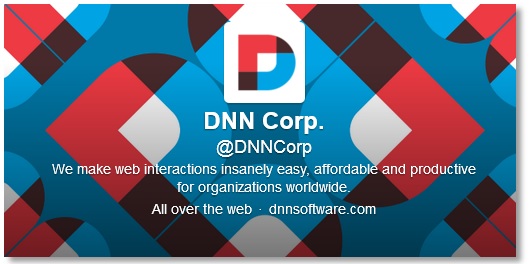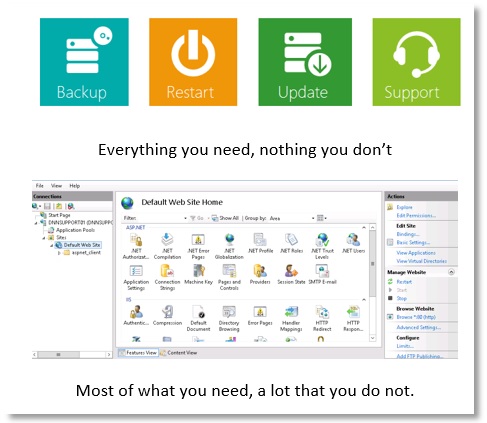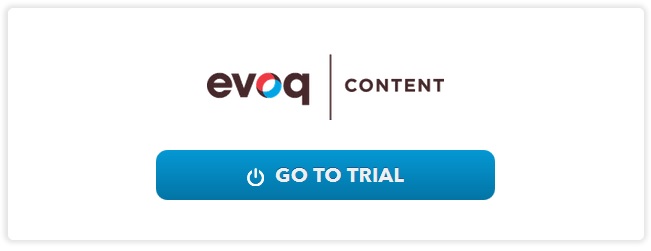Insights on Building DNN as a Service

At DNN, our mission is to “make web interactions insanely easy and affordable.” Sometimes, when pondering a difficult problem I like to go back to think things through from a different angle. As Product Manager for Evoq in the Cloud (our fully managed cloud offering), I’m constantly thinking of ways to improve the overall customer experience in order to make the product more successful.
While going through this thinking exercise recently, I explored the basic value proposition of DNN. Part of the original and persistent appeal of DNN is that we allow a wide range of people – coders and non-coders alike – the ability to easily create and manage a website.
We abstracted away many problems and challenges like authoring of content, user and file management and the ability to change the look and feel of a site without extensive (and expensive!) coding. If you define productivity as “doing more with less,” then we can provide a leap of productivity.
First Analogy: Microsoft’s IIS

DNN runs on top of Internet Information Services (IIS), an extensible web server created by Microsoft. IIS provides the ability for a set of code (DNN) to deliver interactive and beautiful websites to the visitors.
IIS is a very mature technology, originally released in 1995. Anyone working with sites based on IIS became intimately familiar with the management interface, the quirks on how to update the site without breaking it, and a set of related quirks that thankfully have been relegated to the past with each new version. Web developers with experience from this time naturally became IIS experts, or they didn’t succeed.
Second Analogy: Farming Equipment

Photo source: User esivesind on flickr.
I’m reminded of stories from my family of their early days of motoring. In those days, you had to be well-versed in the operation of a vehicle to be able to use one. One day, my late uncle couldn’t get the old farm truck going. The truck had a crank handle start and was a temperamental beast to get started.
After cursing and sweating and receiving bashed knuckles, he took the crank handle out in frustration and gave the front of the truck a severe hit, leaving a permanent dent. Were he still alive today, he would no doubt marvel at key-less entry and the push-button electronic start that cars now have. He’d also be amazed at the latest electric cars that have no need for a starter at all.
Delivering DNN as a Service
In a sense, we can think of as Windows Azure as simply “IIS as a service.” While Windows Azure has a large array of different products and features, for many of us, what we really want to do is simplify the building and delivery of websites, so that we can focus on their most important aspect: content.
Windows Azure users need to rent processors, storage and memory to run IIS, whether using Cloud Services, Windows Azure Websites or Virtual Machines. We wanted to make delivery of Evoq Content or Evoq Social as simple as possible. So we use the Azure API to minimize the essential web interactions down to a single click of the mouse.
Recall: our mission is making it insanely easy to run websites.
Designing Simple Products
The essence of simplicity is taking away everything you don’t really need, and leaving only those things you do. It’s why an iPhone has only two buttons. Sometimes the technically-adept amongst us agitate for a couple more, but that would really spoil the purity of the design.
We don’t need to worry ourselves with the intimate details of IIS when building and delivering DNN sites. To achieve the goal of building “insanely easy and affordable web interactions,” less is always going to be more. That means looking for ways to have less functions available. Fewer buttons means faster learning curves and fewer issues.

In the first image above, I show that it’s entirely possible to distil a service down to a simple set of choices (Note: the top image is not a current or future Evoq in the Cloud design). In the second image, I show that you can provide access to every single individual setting and control.
Most experienced people feel at ease and empowered by something like the IIS Management Console (the second image). But for others who just need a website, it’s not only terrifying, it’s a minefield of potential site problems.
Conclusion
As technically-minded people, we sometimes instinctively fight back against layers that remove our ability to dig our fingers in. Some cars were still built with backup crank-handle start right up until the 1980s, a sure sign that design engineers still wanted ultimate control over the engine. But even the holdouts eventually realised that it was no longer necessary and just complicated the design.

Image source: Staples website.
The direction of Evoq in the Cloud is to look for crank-handle attachments still on the product and remove them. That means taking some of those intensely technical interfaces and options away and replacing them with a big, simple button. When the need to delve deeper arises, you have a support number to call, to get assistance from a single supplier (us!) that manages the entire stack.
Putting simple layers on top of complexities makes the product more accessible for less-technical people and also saves us technical types from ever wanting to strike the web server with a metaphorical crank handle. You can’t get frustrated with cranking if there’s no crank in the first place.
Give Us a Try

Sign up for a free, 14-day trial of Evoq Content, our Content Management System (CMS). Our trial is delivered via the cloud.